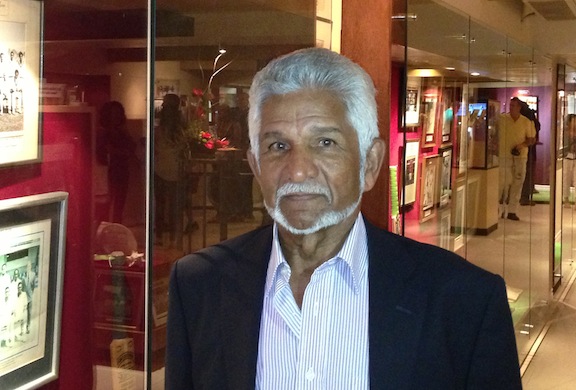Above: the Queen’s Park Oval in Trinidad (CJ Photo)
By Alexander Britell
PORT OF SPAIN — It is not so much a museum as an ongoing archaeological excavation.
For decades, some of the world’s greatest cricketers have passed through the halls and played on the pitch at the Queen’s Park Cricket Club in Trinidad’s capital — notably, local son Brian Lara.
And over the years, they have left their own mementos — a treasure trove of cricket history — from both the West Indies and the world.
Through the efforts of club members and the country’s Ministry of Tourism, the ground floor of the Queen’s Park Oval’s Pavilion has been transformed into the Oval Cricket Heritage Museum, which opened in 2009.
The museum includes old letters, famous photographs, game-used bats and, naturally, a separate section to honour the aforementioned Lara, among other cricket antiquities.
Helping to lead the efforts at the museum is Deryck Murray, a legendary West Indian cricketer and an active club member. The facility is currently curated by Stephen Almandoz, another member at the club, which first opened its doors in 1891.
“It’s really a history of the club, of Trinidad and Tobago cricket and West Indies cricket,” Murray told Caribbean Journal. “What you see in the museum is probably the tip of the iceberg of the things we have, because we’ve been blessed with a number of members who have represented the West Indies at the highest level of international cricket. And as they’ve passed on, they’ve actually left their photographs, their diaries and things with the club.”
Above: Deryck Murray (CJ Photo)
Murray cautions that the museum is simply a start — a way to begin to collect the plethora of artifacts and keepsakes still unclassified, still undocumented hiding in various corners of the Oval. So far, limited space has meant the club has only been able to display so much of its copious inventory.
Above: a print of Lord’s from 1900
The hope, Murray said, is that the current space will be a catalyst for a larger museum, or perhaps even a museum of sport.
“We would like to see it develop like that, but we haven’t even had the room to have all of our own local stuff,” he said. “But we would like it to blossom into something far more regional, rather than purely Queen’s Park or Trinidad and Tobago.”
That could go a long way toward educating a current generation that might not appreciate the history of the sport — and the Windies’ prominent role in it — as much as it should, he said.
“I think there isn’t really [that appreciation] — I think with recent things like the film Fire in Babylon and things like that, people are starting to appreciate it, because I suppose the modern generation is used to their media in conveying messages,” Murray said. “So whereas in the old days we would read books and be satisfied to have read about [English legend] WG Grace and [Australian legend Sir Donald George] Bradman and so on, the modern generation actually needs to see them. So we appreciate that there has to be a different way of conveying the message — and hopefully, if this is one part of it, then that would have done the job.”











